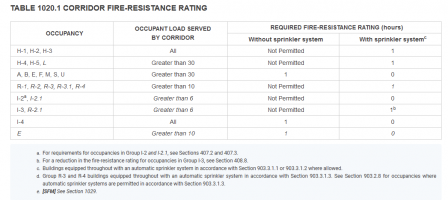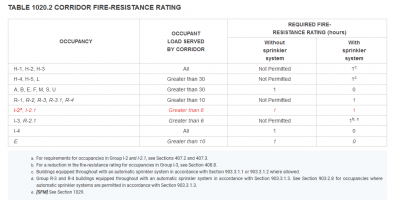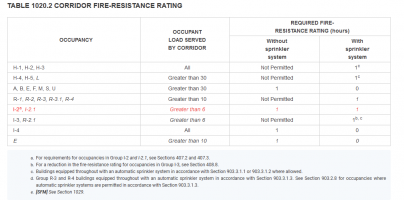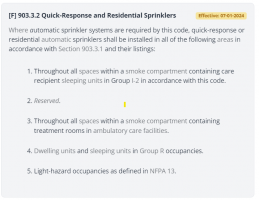2019 CBC

2022 CBC

OK this is a massive change or a massive error.
If you look at the 2019 table a B occupancy in a fire sprinklered building was given an exception for fire rated corridors if per footnote "c" the fire sprinkler system complied with 903.3.1.1 or 903.3.1.2. My understanding was that in order to take this exception the building would need to have been constructed after 1996. Buildings constructed before that date the fire sprinkler system would not comply with 903 and the exception could not be taken. This seemed reasonable as there were many changes to the fire sprinkler installation requirements in the 1996 edition of NFPA 13. I have been constantly battling with brokers who insisted that they could remove and derate all rated corridors and install glass doors and glazing throughout just because they were fire sprinklered.
Now I look at the 2022 CBC table 1020.2 and see that the footnote "c" has been removed from the top "with sprinkler system" notation and placed further down the chart at each occupancy. B occupancy now indicates a "0" rating if protected with a sprinkler system.............................. with no caveat regarding compliance with 903!
looking at the IBC 2015, it was consistent with the 2019 CBC chart. 2018 IBC is now consistent with the 2022 CBC as well
Is this a massive change or an error? any vintage fire sprinkler system will now provide a rated corridor exception?
What do you fine people think?

2022 CBC

OK this is a massive change or a massive error.
If you look at the 2019 table a B occupancy in a fire sprinklered building was given an exception for fire rated corridors if per footnote "c" the fire sprinkler system complied with 903.3.1.1 or 903.3.1.2. My understanding was that in order to take this exception the building would need to have been constructed after 1996. Buildings constructed before that date the fire sprinkler system would not comply with 903 and the exception could not be taken. This seemed reasonable as there were many changes to the fire sprinkler installation requirements in the 1996 edition of NFPA 13. I have been constantly battling with brokers who insisted that they could remove and derate all rated corridors and install glass doors and glazing throughout just because they were fire sprinklered.
Now I look at the 2022 CBC table 1020.2 and see that the footnote "c" has been removed from the top "with sprinkler system" notation and placed further down the chart at each occupancy. B occupancy now indicates a "0" rating if protected with a sprinkler system.............................. with no caveat regarding compliance with 903!
looking at the IBC 2015, it was consistent with the 2019 CBC chart. 2018 IBC is now consistent with the 2022 CBC as well
Is this a massive change or an error? any vintage fire sprinkler system will now provide a rated corridor exception?
What do you fine people think?




